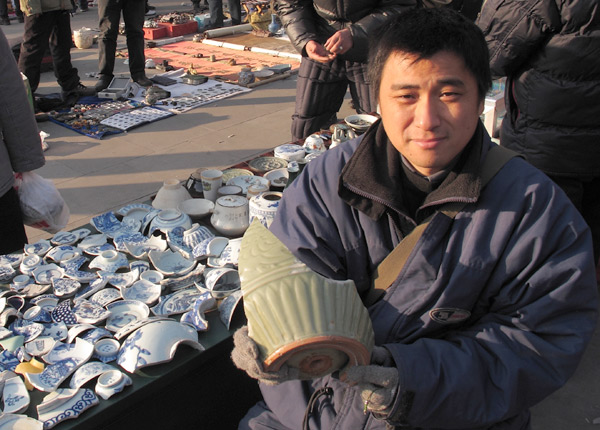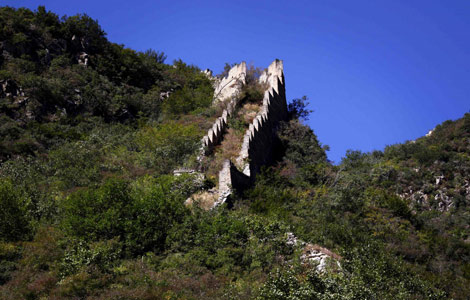Digging pieces of the past
Updated: 2010-12-24 08:07
By Cheng Anqi (China Daily)
|
|||||||||||
BEIJING - You may have seen one of them digging around a construction site, wearing knee-high rubber boots, plastic bucket in hand, and not given them a second thought.
Even if you had, they may have seemed no more than scavengers.
Yet to Zhang Xinhua -- and as many as 1,000 others like him -- what they are scavenging are small chunks of history.
|
 Zhang Xinhua, a ceramics digger in Beijing, shows a fragment of porcelain at his stand in the flea market at Baoguo Temple in this photo taken on Dec 13. [Jiang Dong / China Daily] |
The "ceramics digger", as he and his like have been tagged by the Chinese press, pokes and digs around construction sites, searching for antique ceramic shards buried for decades or possibly centuries.
"Don't regard us as ghouls," said Zhang, 35. "If ceramics diggers didn't look for ancient ceramic chips, the chips would only be crushed down and burned as rubbish. No official organizations have come forward to protect the 'rubbish'."
Zhang said diggers like him keep ancient shards of ceramic alive.
"Many porcelain collectors have a preference for ceramic shards," he said. "They can't afford a whole piece of genuine porcelain, so these ancient ceramic chips satisfy them. Porcelain lovers can hold them in their hands, put them beside their pillows, or in their pockets to strike up conversations with other collectors."
With a broken shard, collectors can see both the outside and inside of the porcelain, giving them a deeper understanding of the ancient art.
Every Thursday and Saturday, Zhang brings the pieces he finds to the flea market at Baoguo Temple, Beijing's largest trading place for ancient porcelain fragments.
Some become treasures of collectors, others go to jewelry shops where they are polished and framed with gold, silver, bronze or rosewood to become jewelry.
With the increasing popularity of porcelain, partly due to the booming collector's market, prices have begun to rise.
A nice fragment of blue-and-white porcelain from the Ming Dynasty (1368-1644) has risen from 10 or 20 cents a decade ago to 500-600 yuan ($75-$90) today. For a bigger fragment from the Yuan Dynasty (1271-1368), the price has skyrocketed to 10,000 yuan.
Three months ago, Zhang sold a piece from the Ming Dynasty for 3,000 yuan, the most expensive one he has picked up from a construction site.
In an average month, Zhang earns around 6,000 yuan.
Zhang, like most of his peers, got into the trade due to his strong fancy toward porcelain.
"Due to my grandpa's influence, I've always loved pottery and porcelain," Zhang said.
In the early 1990s, when Beijing started its large-scale reconstruction within the Second Ring Road, many ancient pieces of ceramics buried beneath residences of aristocrats who once lived in this ancient imperial city started to surface and drew interest from ceramics fanciers.
Some people started digging for more, and a trade in ceramic shards developed around 1996.
However, with increasing media exposure of their trade, many construction sites now impose stricter rules, keeping Zhang and others from coming in and digging.
As a result, Zhang and many of his peers have to negotiate with construction workers and ask them to save the ceramic chips that they find during construction.
They will then return for the chips a few days later, spending up to 500 yuan for one bag of 20 ceramic chips.
On some construction sites where the workers know the shards are treasures, the chip diggers can only pick through the garbage dumped from the site.
Yet until recently, the general public had been fairly oblivious to the chip diggers -- that is until one of them was buried alive when a wall at a construction site suddenly collapsed.
The victim, Yang Xiaolong, 36, whom Zhang knew personally, "worked about the hardest among us".
Zhang said they usually avoid digging under embankments, in places with wet soil, or with deep foundations as these places are most likely to collapse.
"We must be alert when we work. Last year I was looking for ceramic chips in a foundation pit with a partner. Suddenly I heard a slight sound from soil rustling over my head," Zhang recalled.
"That's a sign of soil collapse. We crawled out immediately. There were only about five or six seconds left to escape," Zhang said.
"I think Yang probably saw the gleaming ceramic chips half buried in the soil, and was too excited to keep the warning in mind."











